Battle of Britain Special – Rob Williams & PJ Holden talk Destroyer
16th September 2020
Battle was one of the most ground-breaking of a whole raft of British war comics, but it’s now been more than 30 years since it was on the shelves. But that’s all changing with the publication of the Battle of Britain Special from the Treasury of British Comics on 16 September!
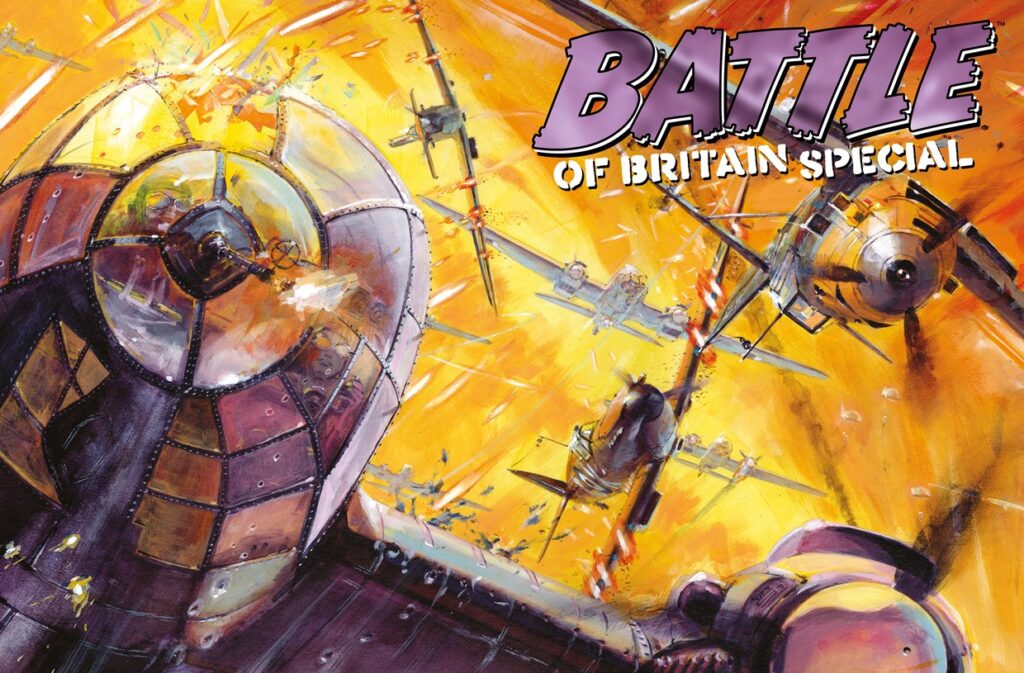
As well as 30 years since the end of Battle, It’s also 80 years since the Battle of Britain, hence the title for this new Rebellion & Treasury of British Comics special.
The Battle of Britian Special is a celebration of the art of war comics, but also mixes in srtips with depth and understanding, reflecting on those lost as well as all that was won.
And one of these strips is Destroyer by Rob Williams and PJ Holden – we caught up with them to talk about the strip and the legacy of war comics.
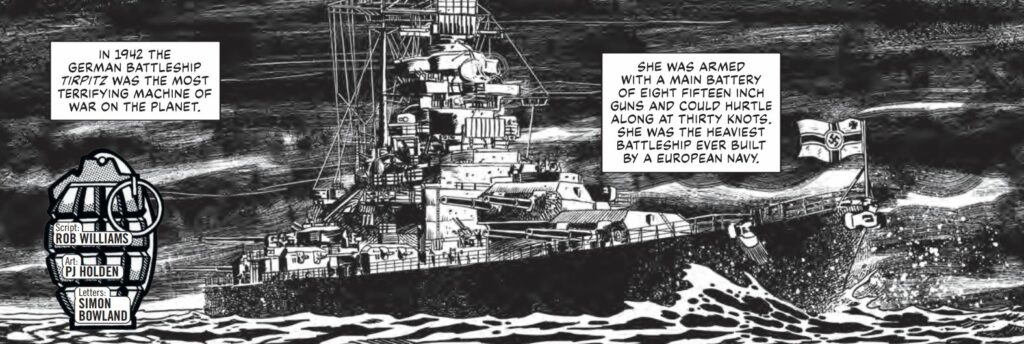
Rob, PJ, The Battle of Britain Special comes out on 16 September, this very week in fact, and inside you have a tale called Destroyer.
So, first things first, what’s it all about?
ROB WILLIAMS: Destroyer is largely based on the true story of HMS Campbeltown, which was an old, ex-US Navy WW1 destroyer that the British packed with explosives and sent to to try and ram the Dry Dock at St Nazaire. It’s one of the crazy, you can’t believe it’s true, ‘Death Star’ run-style World War 2 stories. This immensely well defended military port was about to house the Tirpitz, and if it did, the German battleship could have changed the course of the war in the North Atlantic. So some bright spark decided to drive in the front door at night and try and knock out the dry dock so there was nowhere for the Tirpitz to be repaired on Atlantic coast. Incredible bravery.
Yes, that whole saga of a supposedly jinxed old destroyer on a mission like this, it really is one of those you simply couldn’t make it up tales.
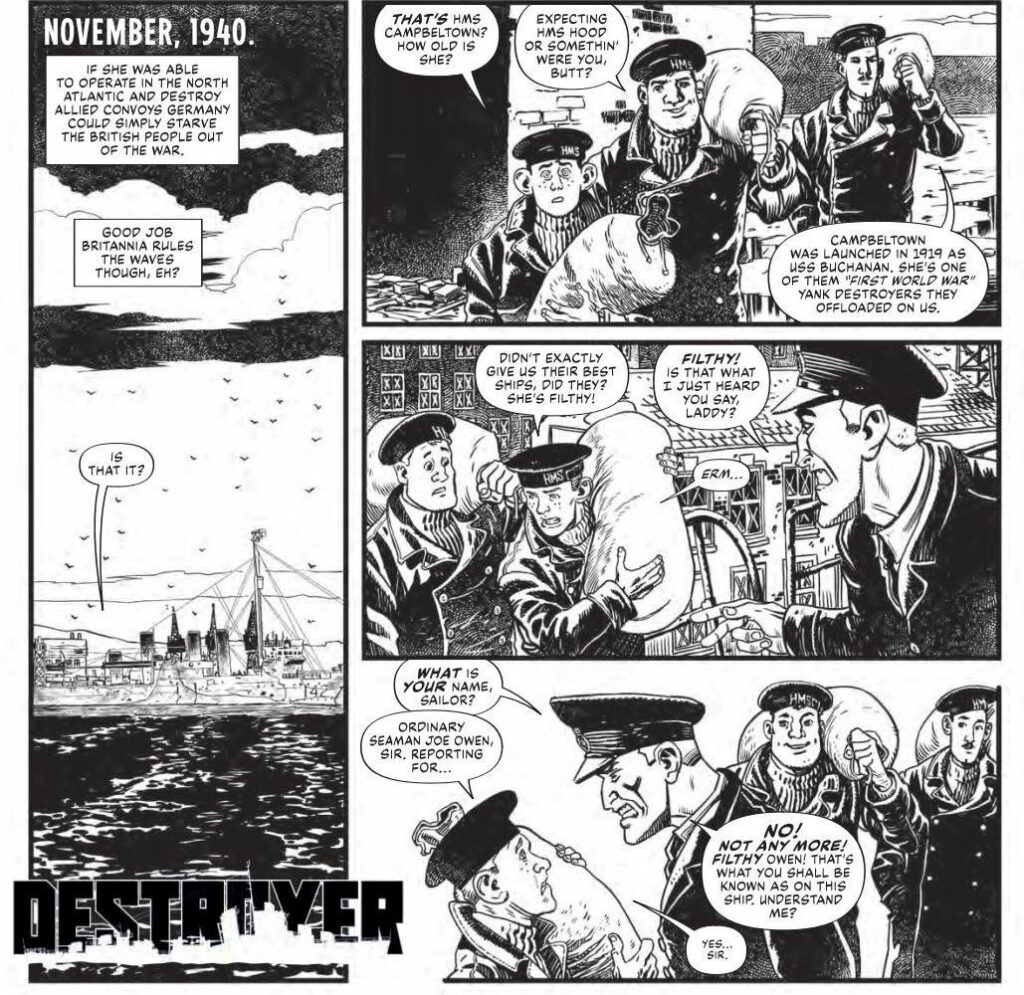
In previous eras, it might have been covered somewhat differently, the comics before Battle came out would have focused on the success of the operation. Whereas those original Battle tales and in Destroyer, you’ve delivered all the sense of adventure but tempered it with the terrible realities AND the wonderful sense of camaraderie of the trio of sailors you use as your everymen.
RW: It’s a lot to try and do in 8 pages. Perhaps too much. The raid itself could have been a 20-page comic, easily. But for me the Campbeltown was this exciting underdog tale. A jinxed, rather outdated little destroyer and her crew ends up playing a huge role in stopping one of the great battleships of World War 2.
And, of course, because the St Nazaire raid was true and a lot of sailors and commandos died, you want to try and do justice to the young men who must have been scared out of their wits the night of the assault, but still went through with the raid. It’s, hopefully, a respectful doff of the cap.
Oh, I think it is, I really do.
RW: Yes, it’s a successful mission, but not the way anyone expected, and there’s a heavy price to be paid. Of the 621 men who went on the mission only 227 returned home. So, you want this to be an emotional journey and not just a factual info dump.
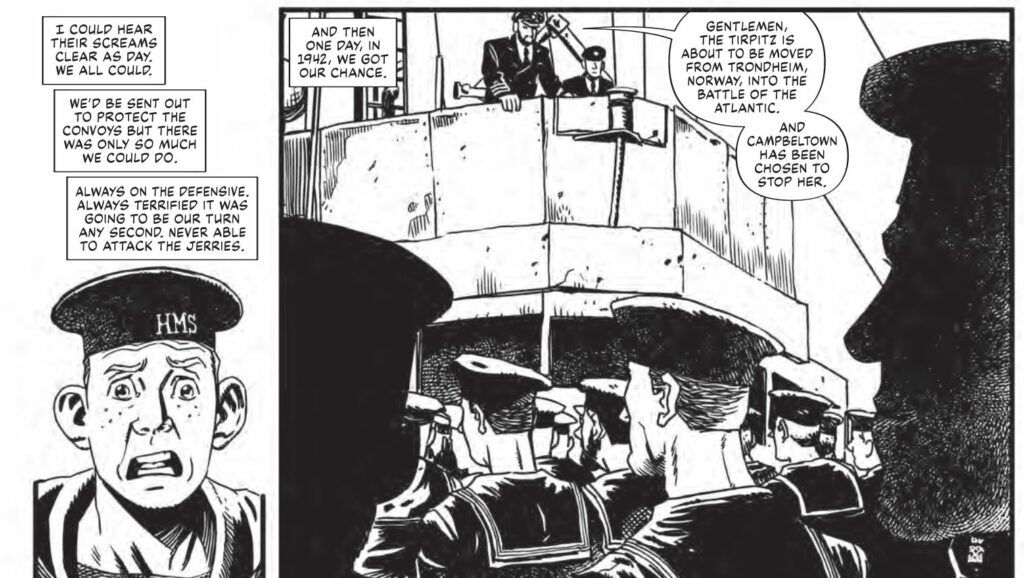

Now, presumably, putting together this sort of tale relies on a lot of research Rob, getting those little things right?
RW: a bit, yes. There’s an excellent documentary on the Campbeltown raid that Garth Ennis pointed me towards and that helped. And then it was doing some internet research. I’m a bit of a World War II military history reader anyway, so this was all the type of thing I enjoy reading about anyway. But you have to try and do due diligence when dealing with real events, even if our three lead characters are fictionalised.
We did change one aspect of the story though. In reality, the Campbeltown’s bridge was shot up and the officer who planted the explosives ended up taking the wheel as everyone else was hit, and he steered it into the dry dock wall. We’ve taken some artistic license there.
However, compared to the plight of the poor artist, you have it pretty easy, right? Just a couple of google searches and it’s all there? Poor old PJ has to get the really important stuff down just right – all of that visual research?
RW: PJ’s had war reference beaten into him by Ennis on their various excellent war stories. So he’s a dab hand at this stuff now.
I was amazed when Peej came out with exact depictions of the Tirpitz and Campbeltown. He’s done a terrific job on the story. Both in terms of the action and the humanity of our three leads. It’s one of PJ’s best, I think.
PJ HOLDEN: YES. I’m glad it’s finally acknowledged just how much more work an artist puts in than a writer.
Oh sure, “Then the big boat hits the other big boat. PS I dunno its name” is enough to pass muster for the script droid, but now I’ve gotta go away and find these bloody boats.
And finding a picture isn’t as easy as you think, not all of these ships have photos, sometimes you’ll end up having to find out their history in order to find the name of their sister ship which MIGHT have a photo somewhere, and then you’ll be faced with trying to work out what size they look in relation to each other (because there’s never a photo of the incident) and then you’ll sometimes need to figure out exactly how the ship crashes, you’ll make some basic assumptions and then you’ll go off and find an accident report that details that it was hit in the port or starboard side (and then you’ll remember you don’t know anything about boats and you can’t tell which is port and which is starboard) and and and and…
Anyway, it is properly exhausting.
I don’t think I was daunted by it, I’m just stupid enough to forget how hard the last war comic is that I think “Oh I’d like to draw more war stuff!”. Frankly, if I had the memory capacity I’d probably throw my tools down in disgust and vow to never draw another war story again.
(Also: getting the chance to work with Rob is always lovely, hopefully we’ll get to do more things together)
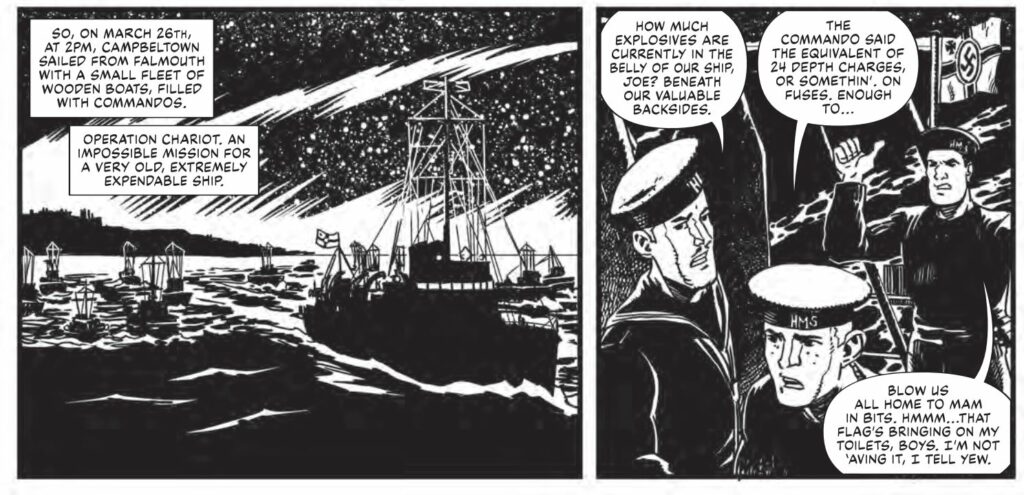
And as far as the most difficult thing about doing this sort of comic, I suppose it’s getting the right tone. After all, we’re dealing with real men here, real deaths, families that will be affected.
PJH: Well, now I feel bad about the last rant. Yeah, these are real incidents. I think my approach was to get the art as accurate (in terms of period feel, accuracy of vehicles, etc) as I was able, while trying to pay homage to the Battle comic (because this is still an action/adventure comic).
As it happens, when I was about 14 I started working in a computer shop that had begun life as a radio shop started by two veterans of the Merchant Navy’s war. It was something they never talked about, but there was humour there. So that was always in the back of my head too. They went to war as kids effectively and no doubt saw some horrors.
RW: I read HMS Nightshade before writing this, which is an absolutely superb work by John Wagner and Mike Western from Battle‘s heyday. That was a touchstone for the tone we’re taking here. Hopefully respectful. The sense of the cost of war.
Oh yes, it’s mentioned in the Battle interview piece by Karl Stock (Judge Dredd Megazine issue 424) that you were originally thinking of doing an HMS Nightshade story but were sort of warned off it by Garth Ennis?
RW: Ha, not warned off per se. I said I was thinking of doing HMS Nightshade and Garth said that was brave as he believes it might well be John Wagner‘s finest work. I read it and saw what he meant. Nightshade is also a definite story with a start-middle-end. It didn’t need a Johnny-come-lately telling one more episode. Garth absolutely loves Battle and has a vast knowledge of it, so he was a good sounding board for me.
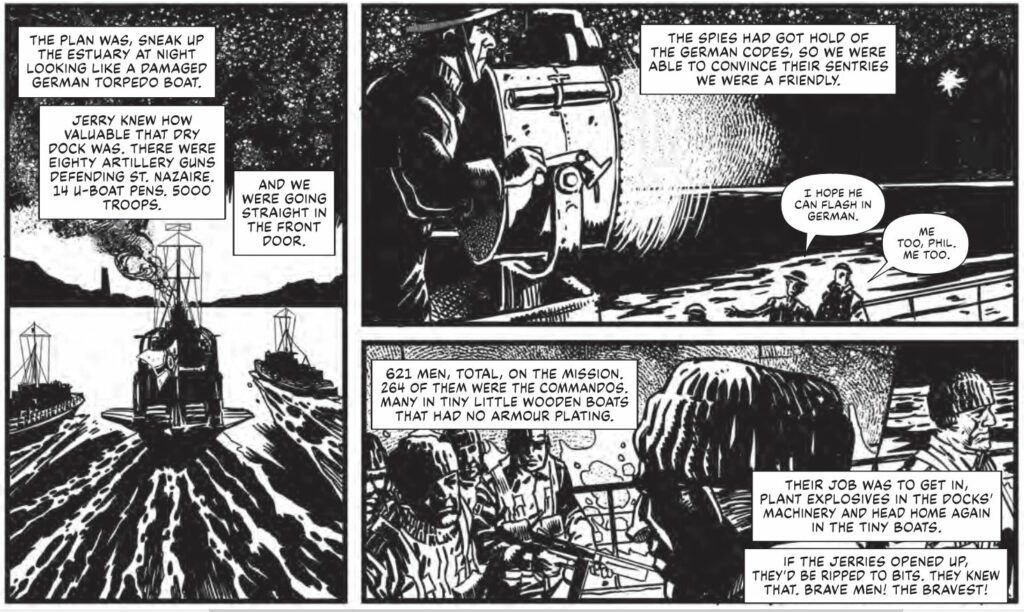
Given the small number of pages you have here to properly tell the Cambeltown’s story, how do you go about getting the right mix of storytelling to move the events along, the laughing and joking of your three ‘everyman’ sailors, and the terrible tragedy.
RW: As I said, it’s probably a bit over ambitious to try and carry all those things in an 8-pager. The setup, the stakes, the characters and then the mission. It’s a testament to PJ’s skill that we’re cramming a lot into those mission pages and he makes it all clear.
PJH: I think this largely plays to my strengths so it didn’t feel tough to go from awful battles to goofy people. One of the key things, I think, was getting the rendering right – get that right and I think people will give you more leeway on how cartoony you can get, and cartoony faces can read much more directly to a reader, you feel a more direct connection to them when you can feel their emotional state from their faces.
For instance, on page four, there’s that sequence first of OS Owen – ‘Filthy Owen’ getting knocked overboard when an unfortunate coaster ship collides with the Jinxtown and sinks. He’s fine, but his thoughts of the men desperately attempting to escape the coaster as it sunk.
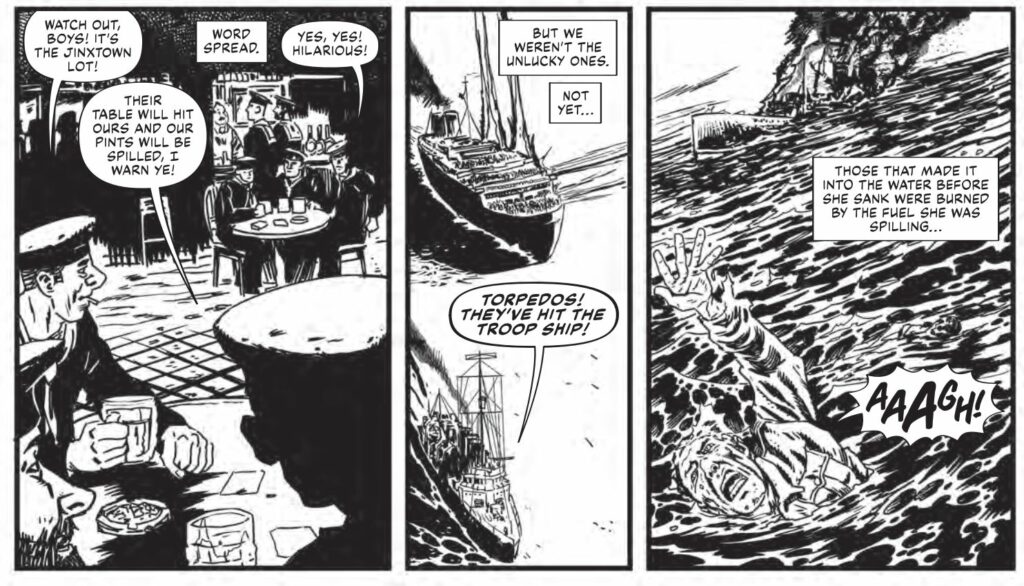
But that’s nothing to just a few panels on. First you give us that little bit of lightness in the pub and the teasing of the ‘Jinxtown lot’, but immediately after that, it goes very, very dark very quickly as Owen describes the after-effects of a torpedo hit and what happens all that fuel goes up. Hideous. And, of course, all of this plays grimly with the events that play out.
PJH: I suspect lots of this falls to how much information we’ve gotta cram in, and Rob is the real star on that front (we chat often and he would apologise about just how much stuff we’re covering in those scant 8 pages).
But you know, you get the script and you try and make it work so it doesn’t feel jarring, of course dialogue and captions (and the lettering generally) all plays a part.
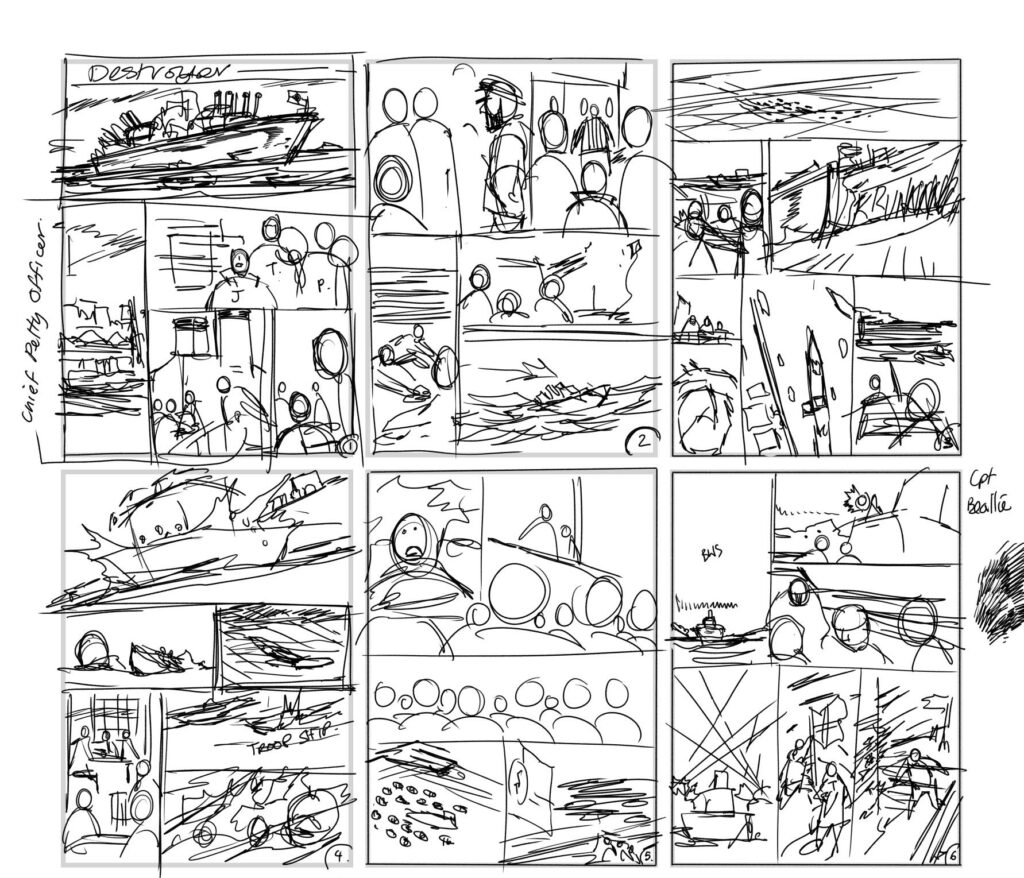
You’ve obviously got a love of drawing these gorgeous wartime comics, having recently worked with Garth Ennis on Stringbags.
PJH: Well, like Garth, and Rob, I grew up reading war stories, and watching B&W war movies on the telly. I had no particular loyalty to any genre, but war stories in Warlord, Battle and Commando were more readily available to me than superhero stories (and even when 2000 AD showed up, as much as I loved it, I REALLY loved it when Rogue Trooper introduced future war!)
PJ, you’ve recently seen Stringbags published with Garth Ennis, a similar theme of air battle rather than sea – what’s the difference between working on that larger, full-length graphic novel and working here on just a few pages to get across the entire story?
PJH: Well, there’s a practical difference, Stringbags (and strictly speaking it’s air-sea battles!) was drawn over a year so there’s always a shift in your art style, stuff moves and changes as you’re style develops or you find shortcuts, whereas with Destroyer I knew exactly how I wanted it to look – I wanted the feel of textured paper, originally it was to be coloured, but I think seeing the rendering Rob and I both felt it would work in B&W.
I’ll come clean: the rendering is mostly me applying a thumbprint brush, adding and removing texture, the entire strip was inked digitally, some may consider that cheating… I don’t.
I’ve absolutely fallen in love with rendering water. I’d love another sea-based strip to get good at it.
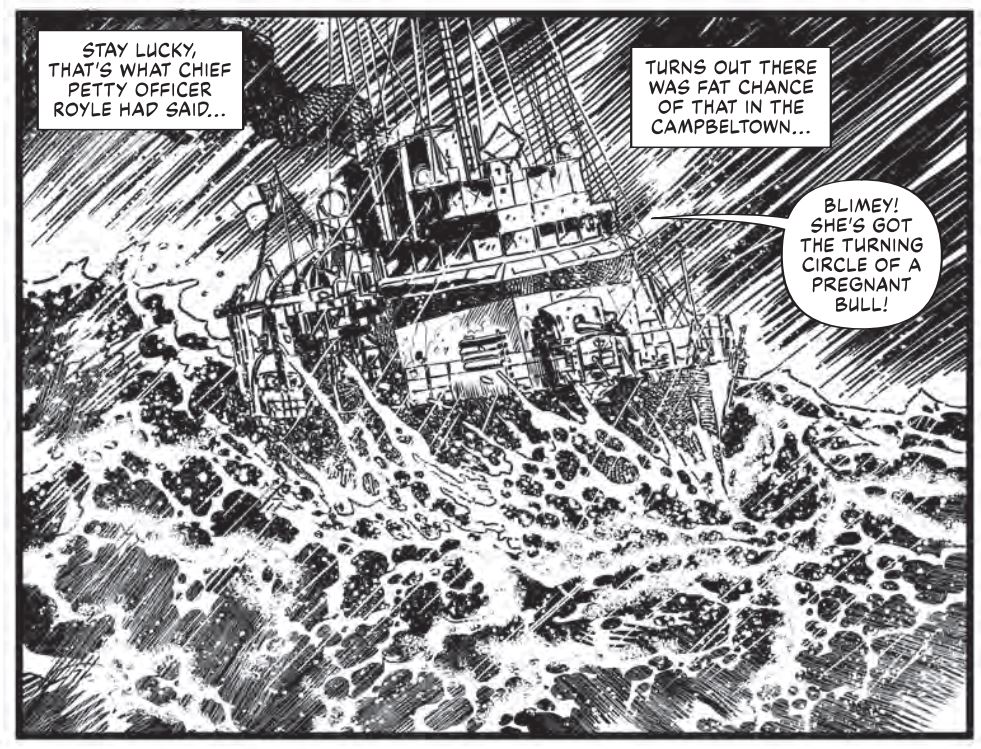
Yes, I was going to mention the water – seriously, there’s some beautifully drawn water in Destroyer. How do you make that look so darned great?
PJH: Go to the masters, Dave Gibbons, Mike McMahon, Joe Colquhoun and more, steal from them, and try not to do a terrible job of it.
How gutting is it, in a limited page count story such as Destroyer, to do something quite so spectacularly beautiful and impressive as that image of the Cambeltown ploughing through rough seas on page 2 and not be able to show it as a splash page, or at the least a half-page panel?
PJH: Well, thank you for that! I’m not sure if the strip was longer I might have drawn in a slightly different style and it may not have looked so impressive – the rendering I used here well, while not labour intensive, certainly felt right for a short strip – if it was 176 pages of that rendering it might have become tiring. Sometimes less is more.
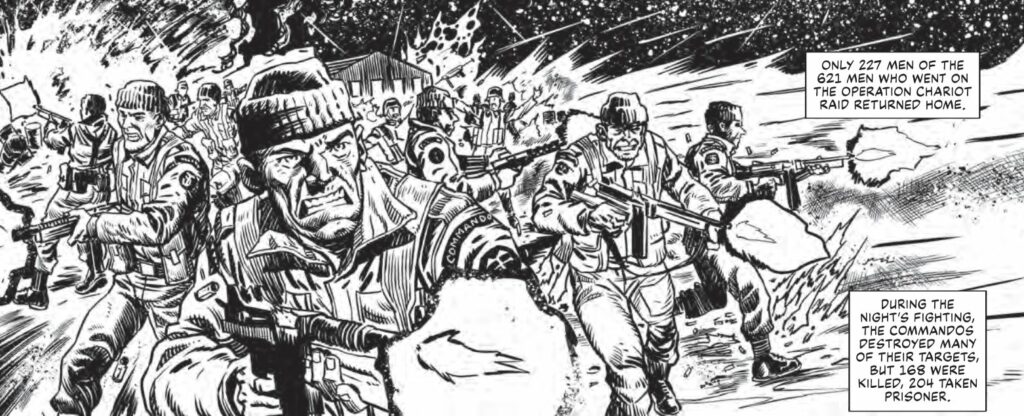
And I have to say, there’s a moment in Destroyer where I reckon you’ve absolutely captured the epitome of what I imagine a WWII commando would look like – something that’s right out of the Action Man/ Airfix toys mold.
PJH: Haha, that was a fun panel to do, and I think again if the strip had been longer I don’t know if we’d have had a panel like that – it’s trying to convey a film montage as much as a single bit of action. (And look, I’m taking all of these complements, and I’m allowing my brain to accept them as true and valid, but I do so knowing full well that if I take a look at the art I’ll find myself vehemently disagreeing!)
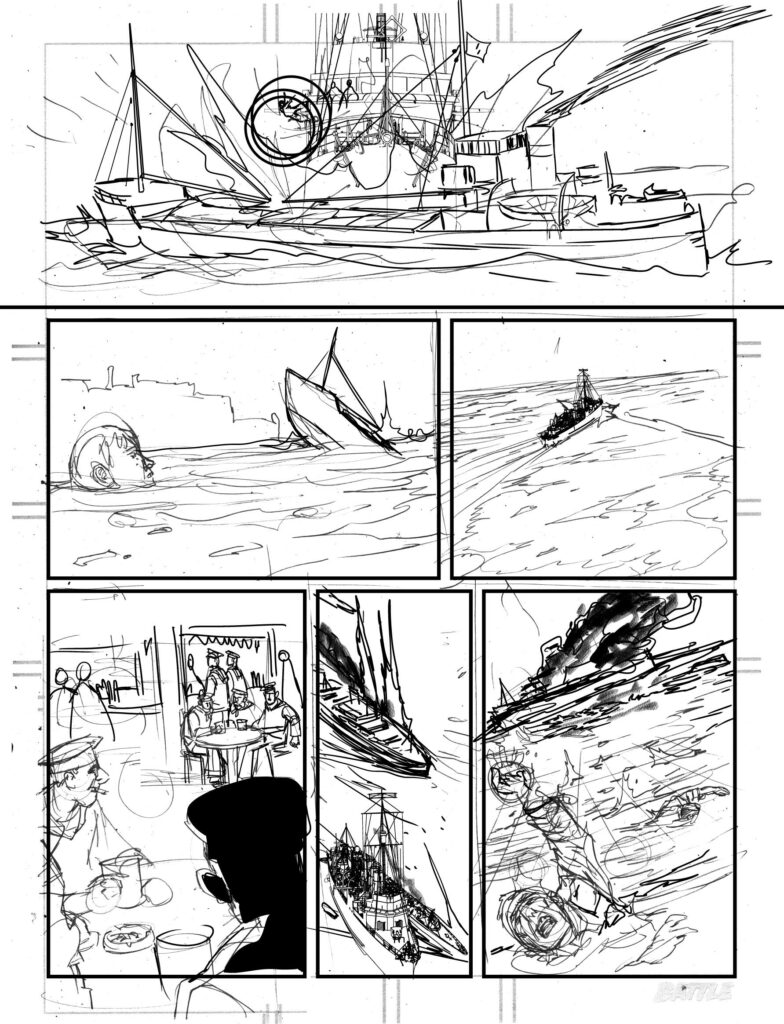
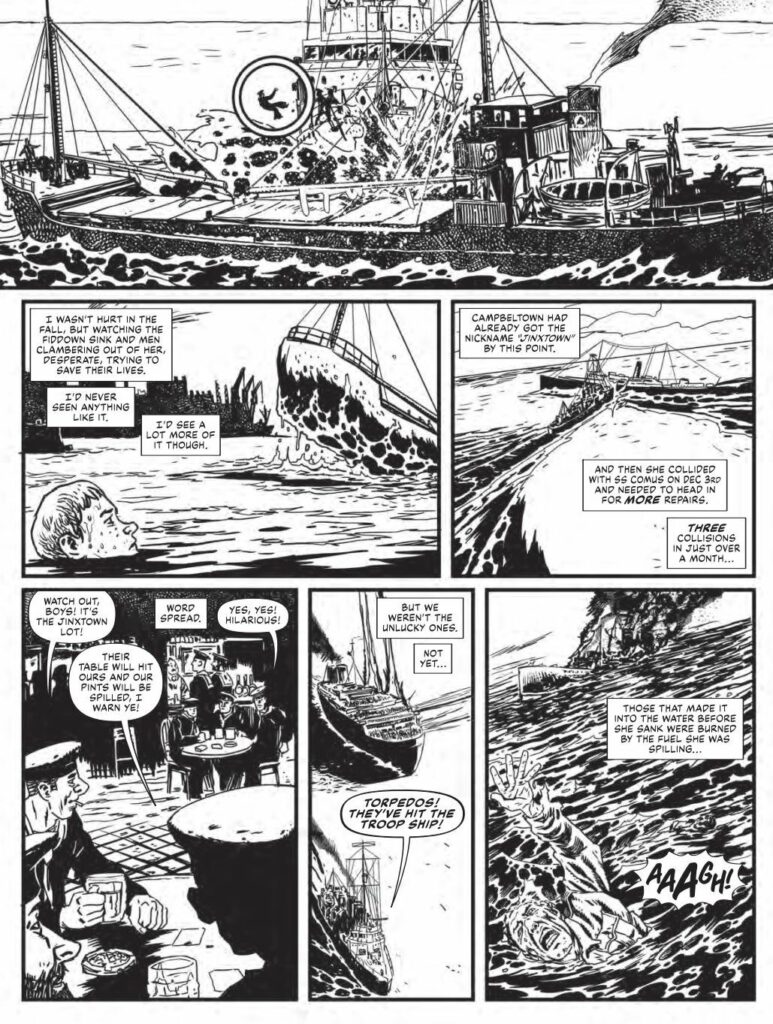
PJ, you were a Warlord fan as a kid, right?
Oh yeah, proper Warlord fan, member of the fan club – wrote a letter with a joke, which I stole from an even older Lion annual, I think – two sailors staring into sea – beyond them, floating towards them a vision of a mine looms in to view – “MINE!” shouts one sailor, “YOU CAN KEEP IT!” shouts the other.
Firstly, let me publicly apologise for the stealing of that joke – though it never got accepted in Warlord – but it could be what scuppered me was writing the entire thing in the Warlord code – a simple rot13 cypher – or the Caesar cypher – I assumed a huddled group of die-hard Warlord veterans would see this encoded message, crack the code, guffaw at my charming telling, commission an artist to draw it and then run it the following week. But it was more likely a tired editor saw this letter come in, written in gibberish and just binned it.
Okay, finally, would you be hoping to tell more tales for Battle if/when we get to see another Special or something more coming from the Treasury of British Comics?
RW: Absolutely. This Special’s a fantastic package. It’d be fantastic to do more. And there’s a good few of us comic creators who love telling war stories but we don’t often get the chance to scratch that itch.
PJH: Oh absolutely. Once we did this, I saw something, I think it was a documentary or something, I saw the PERFECT subject for another Destroyer strip – and phoned Rob and told him about it, something I don’t remember seeing covered in anything else before.
And whilst on the subject of the future, would there be any classic Battle series that you’d fancy a crack at?
RW: Anything aircraft related. I’d give Johnny Red a go, I guess.
PJH: I think Keith has all the classic stuff well covered, if anything I’d love the chance to come up with something entirely new for Battle, and you know, one of the virtues of the Destroyer strip – is that it can be about anything as long as it includes a destroyer…
Absolutely – and hopefully, we’ll be seeing Rob and PJ collaborating on another Destroyer strip in the future. But our thanks to Rob & PJ for talking to us about Destroyer. It’s one of the stand-outs in this Battle Special and well worth checking out!
The Battle of Britain Special comes out on 16 September – get hold of your copy through the web shop and get the gorgeous Keith Burns web exclusive cover!

